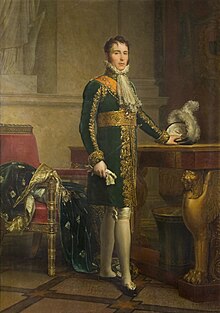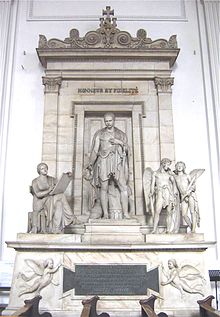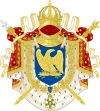Eugène de Beauharnais
| Eugène de Beauharnais | |
|---|---|
| Prince of Venice, Grand Duke of Frankfurt, Duke of Leuchtenberg, Prince of Eichstätt | |
 Portrait of Prince Eugène de Beauharnais, Viceroy of Italy, by Andrea Appiani (1810) | |
| Viceroy of Italy | |
| Term | 5 June 1805 – 11 April 1814 |
| Monarch | Napoleon I |
| Duke of Leuchtenberg Prince of Eichstätt | |
| Tenure | 14 November 1817 – 21 February 1824 |
| Successor | Auguste de Beauharnais |
| Born | 3 September 1781 Paris, France |
| Died | 21 February 1824 (aged 42) Munich, Bavaria |
| Burial | |
| Spouse | |
| Issue | |
| House | Beauharnais |
| Father | Alexandre de Beauharnais Napoleon I (adoptive) |
| Mother | Joséphine Tascher de la Pagerie |
| Religion | Roman Catholicism |
| Signature | |
| Military career | |
| Allegiance | |
| Battles / wars | |
Eugène Rose de Beauharnais (French: [øʒɛn də boaʁnɛ]; 3 September 1781 – 21 February 1824) was a French nobleman, statesman, and military commander who served during the French Revolutionary Wars and the Napoleonic Wars. Through the second marriage of his mother, Joséphine de Beauharnais, he was the stepson of Napoleon Bonaparte. Under the French Empire he also became Napoleon's adopted son (but not the heir to the imperial throne). He was Viceroy of the Kingdom of Italy under his stepfather, from 1805 to 1814, and commanded the Army of Italy during the Napoleonic Wars. Historians consider him one of Napoleon's most able relatives.[1]
Family
[edit]Eugène Rose de Beauharnais was born in Paris on 3 September 1781 as the son of Viscount Alexandre de Beauharnais and Marie-Josèphe Rose Tascher de la Pagerie (future empress Josephine), both born in the French colony of Martinique. His parents separated when Eugène was three years old. At the age of five, Eugène was entrusted to his father's care, attending various boarding schools. His father served as a general during the early Revolutionary Wars. After losing the Siege of Mainz (1793) he was imprisoned and executed by guillotine on 23 July 1794, a few days before the fall of Maximilien Robespierre and the end of the Reign of Terror.[2]
Early career
[edit]
Eugène joined the French Revolutionary Army soon after his father's death, initially serving as an orderly to General Lazare Hoche during the War in the Vendée.[3] However, within a year his mother Joséphine had arranged his return to Paris, after she remarried to Napoleon Bonaparte.[4] After joining the 1st Hussar Regiment as an assistant sub-lieutenant on 30 June 1797, Eugène served as an aide-de-camp to his stepfather in the Italian campaign.[4] After the Treaty of Campo Formio (17 October 1797) he was sent on missions to the Ionian Islands and Rome.[4] In 1798, he followed Napoleon in his campaign in Egypt and Syria, where he took part in the Siege of Jaffa and was wounded during the Siege of Acre.[4]
Eugène returned to France with Napoleon in the autumn of 1799, helping to bring about the reconciliation of the general and his mother, who had become estranged due to their mutual extramarital affairs. During the Coup of 18 Brumaire, he accompanied Napoleon to Saint-Cloud, where they brought the Council of Five Hundred into submission. When Napoleon became First Consul following the coup, Eugène was appointed captain of the chasseurs à cheval of the Consular Guard.[4] He distinguished himself in the Guard's cavalry charges at Battle of Marengo, and was promoted to chef d'escadron.[4][5] In 1803 he bought Hôtel Beauharnais.

After rising through the ranks under the Consulate, Eugène was promoted to brigade general soon after the establishment of the Empire in 1804.[4] By a decree of 1 February 1805, Eugène was created Arch-Chancellor of State[4] and made a prince of France.
Viceroy of Italy
[edit]
As commander of the Imperial Guard (successor to the Consular Guard), Eugène preceded his stepfather to Milan ahead of Napoleon's coronation as King of Italy on 26 May 1805. Napoleon had originally intended to place his brother Joseph on the Italian throne and then, after Joseph's refusal, his nephew Napoléon Charles, the son of Louis Bonaparte and Eugène's sister, Hortense. However, both Joseph and Louis refused, so Napoleon placed the Iron Crown upon his own head instead. During the coronation, Napoleon handed the royal ring and mantle to his stepson and on 7 June 1805 announced Eugène's appointment as Viceroy of Italy to the Italian Legislative Assembly.[6]
In 1805, the War of the Third Coalition was to test Eugène's talents as an organizer, if not as a commander.[4] While General André Masséna commanded the Army of Italy, Eugène raised a reserve army to guard the kingdom's southern border, after Naples broke its neutrality agreement with France.[4] After the French victory at Austerlitz, Napoleon sought to strengthen Bavaria's alliance with France and arranged Eugène's marriage to Princess Augusta of Bavaria, daughter of King Maximilian I Joseph of Bavaria, breaking her engagement to Charles, Hereditary Prince of Baden. On 12 January 1806, Eugène was officially adopted by Napoleon.[4] Though excluded from succession to the French Empire, on 16 February 1806 he was declared heir presumptive to the Italian throne, in the absence of a second son of Napoleon.[4]
Over the following years, Eugène dedicated himself to the management of the Kingdom of Italy, showing himself an astute politician and administrator.[4] He oversaw military works (fortification of Mantua, expansion of the Rocca d'Anfo), public works (construction of roads, restoration of the Venetian Arsenal, draining of the marshes around Verona), and the promulgation of the Napoleonic civil, commercial, and penal codes.[4] After the kingdom annexed the Marches from the dissolved Papal States, in April 1808, Eugène managed to keep relations with the Holy See from breaking down and rallied the populations of the annexed areas through economic benefits.[4]
During the War of the Fifth Coalition, Eugène was put in command of the Army of Italy with some highly competent generals like Grenier, Charpentier, and the future marshal Étienne MacDonald accompanying him as advisers and officers.[7] In April 1809, he fought and lost the Battle of Sacile against the Austrian army of Archduke John, but Eugène's troops won the rematch at the Battle of the Piave in May and the Battle of Raab in June.[7] After the Battle of Aspern-Essling, Napoleon recalled the Army of Italy to Austria.[7] After joining the main army on the island of Lobau in the Danube, Eugène took part in the Battle of Wagram.[7]
Napoleon considered making Eugène regent of France during the invasion of Russia but ultimately decided against this.[8] During the campaign, Eugène again commanded the Army of Italy (IV Corps), with a total force of 80,000 men. He fought at the battles of Ostrovno, Vitebsk, Smolensk, Borodino, Maloyaroslavets, Krasnoi, and the Berezina.[3] After Napoleon and then Joachim Murat had left the retreating army in December 1812, Eugène took command of the remnants of the Grande Armée at Poznań.[9] He led the retreat to Leipzig from January to May 1813, then served under Napoleon at the Battle of Lützen.[3][4] Eugène then returned to Italy, where he set about reorganizing his troops and preparing the defence against the Austrian Empire.[4]
Despite the defection of Murat's Kingdom of Naples in January 1814, and pressure from his Bavarian father-in-law, Eugène refused to defect to the Coalition, while also rejecting calls to leave behind his kingdom and join Napoleon in the defence of France.[4] During the Italian Campaign of 1813-1814, he commanded a series of engagements in the Po Valley in order to slow down the enemy advance, which were in effect a series of organized retreats up to the river Adige.[4] Despite some success against the Austrians at the Battle of the Mincio River on 8 February 1814, and successive victories against the Neapolitan Army, he was beaten at the rivers Taro and Nure.[4] On 16 April, five days after Napoleon's abdication of both the French and Italian thrones, Eugène signed the Convention of Schiarino-Rizzino with the Austrian commander Heinrich von Bellegarde, bringing an end to hostilities.[3] His attempt to be crowned King of Italy failed after an insurrection in Milan on 20 April, and Eugène finally relinquished control of the kingdom in the Convention of Mantua on 23 April.[3]
Later life
[edit]
After the fall of the Kingdom of Italy, Eugène retired to Munich in June 1814 at the behest of his father-in-law.[3] He soon returned to Paris on the death of his mother, where he was honourably received by Louis XVIII and Alexander I of Russia.[4] He immediately renounced his political activity and returned to his wife's family in Bavaria.[4] Accordingly, he remained neutral during Napoleon's return to power in the Hundred Days.[4]

As Duke of Leuchtenberg, Eugène lived his last years in Munich managing his estates and expanding his art collection. At the same time, he provided assistance for proscripts under the Bourbon Restoration, such as Antoine Marie Chamans de Lavalette, and lobbied for the alleviation of the harsh treatment imposed on Napoleon in his captivity in Saint-Helena.[4] In 1822, Eugène's health began to deteriorate. After suffering two attacks of apoplexy in 1823, he died on 21 February 1824 in Munich, aged 42.[4]
Marriage and issue
[edit]On 14 January 1806, two days after his adoption by Napoleon, Eugène married Princess Augusta Amalia Ludovika Georgia of Bavaria (1788–1851), eldest daughter of Napoleon's ally, King Maximilian I Joseph of Bavaria. Although a diplomatic marriage, this union would turn out to be a happy one. On 14 November 1817, his father-in-law made him Duke of Leuchtenberg and Prince of Eichstätt, with the style Royal Highness.
Eugène and Augusta had seven children:
- Princess Joséphine Maximiliane Eugénie Napoléonne de Beauharnais (1807–1876); became the Queen Consort to King Oscar I of Sweden, himself the son of Napoleon's old love, Désirée Clary.
- Princess Eugénie Hortense Auguste de Beauharnais (1808–1847); married Friedrich, Prince of Hohenzollern-Hechingen.
- Prince Auguste Charles Eugène Napoléon de Beauharnais, 2nd Duke of Leuchtenberg (1810–1835); married Queen Maria II of Portugal. There was no issue with this marriage.
- Princess Amélie Auguste Eugénie Napoléone de Beauharnais (31 July 1812 – 26 January 1873); was the second wife of Pedro I of Brazil (father of Maria II of Portugal) and became Empress of Brazil.
- Princess Theodelinde Louise Eugénie Auguste Napoléone de Beauharnais (1814–1857); married Wilhelm, 1st Duke of Urach.
- Princess Carolina Clotilde de Beauharnais (1816)
- Prince Maximilian Josèphe Eugène Auguste Napoléon de Beauharnais (1817–1852); married Grand Duchess Maria Nikolaievna of Russia, eldest daughter of Tsar Nicholas I of Russia, and received the title of "Prince Romanovsky", addressed as "His Imperial Highness", in 1852.
Roles and titles
[edit]On 20 December 1807, he was given the title of Prince de Venise ("Prince of Venice"), a title created on 30 March 1806, when the Venetian Province taken from Austria in 1805 was united to Bonaparte's Kingdom of Italy.
In 1810, Napoleon used his influence over Karl von Dalberg, Archbishop of Regensburg and Grand Duke of Frankfurt, to name Eugène as constitutional heir of the grand duchy. Von Dalberg abdicated on 26 October 1813 due to Frankfurt's imminent conquest by the allied armies, and Eugène became nominal grand duke until Frankfurt was occupied by the allies in December of that same year.
A further imperial sinecure was Archichancelier d'État de l'Empire de France ("Archchancellor of State of the Empire of France").
His name is inscribed on Column 24 of the Southern Pillar of the Arc du Triomphe, reading BEAUHARNAIS.
Battle record
[edit]- Battle of Sacile (1809) - Defeat
- Battle of Caldiero (1809) - Defeat
- Battle of Piave River (1809) - Victory
- Battle of Tarvis (1809) - Victory
- Battle of Raab (1809) - Victory
- Battle of Wagram (1809) - Victory
- Battle of Borodino (1812) - Victory
- Battle of Maloyaroslavets (1812) - Indecisive
- Battle of Lützen (1813) - Victory
- Battle of Caldiero (1813) - Victory
- Battle of the Mincio River (1814) - Victory
Heraldry
[edit]-
Monogram of Eugène de Beauharnais
-
Coat of arms as
French Prince -
Coat of arms as
Viceroy of Italy -
Coat of arms as
Duke of Leuchtenberg
References
[edit]- Citations
- ^ Caulaincourt 1935, p. 403.
- ^ Tucker 2015, p. 68.
- ^ a b c d e f Six, Georges (1934). "BEAUHARNAIS (Eugène-Rose, prince de)". Dictionnaire biographique des généraux et amiraux français de la Révolution et de l'Empire : 1792-1814 (in French). Vol. 1. Paris: Librairie Historique et Nobilaire. p. 66.
- ^ a b c d e f g h i j k l m n o p q r s t u v w x y Beaucour, Fernand (January 1971). "BEAUHARNAIS, Eugène de". Revue du Souvenir Napoléonien (257). Translated by Hicks, Peter: 41–42. Retrieved 1 July 2021.
- ^ Connelly, Napoleon's Satellite Kingdoms, p. 22.
- ^ Miller, E.J. (1967). "The Napoleonic Kingdom of Italy". The British Museum Quarterly. 31: 3/4 – via www.jstor.org/stable/4422964.
- ^ a b c d Rothenberg, Gunther E., 1923-2004. (2004). The emperor's last victory: Napoleon and the Battle of Wagram. London: Weidenfeld & Nicolson. ISBN 0297846728. OCLC 56653068.
{{cite book}}: CS1 maint: multiple names: authors list (link) CS1 maint: numeric names: authors list (link) - ^ Zamoyski, Adam. (2005). 1812 : Napoleon's fatal march on Moscow. London: Harper Perennial. ISBN 0007123744. OCLC 57382666.
- ^ Korolev, N. (29 May 2014). "A day trip to Zvenigorod". Russia Beyond the Headlines. Retrieved 29 January 2020.
- Bibliography
- Caulaincourt, Armand-Augustin-Louis (1935). With Napoleon in Russia. Translated by Jean Hanoteau. New York: Morrow.
- Oman, Carola Napoleon's viceroy, Eugène de Beauharnais London: Hodder & Stoughton, 1966.
- Tucker, Spencer C. (2015). 500 Great Military Leaders. ISBN 9781598847581.
External links
[edit]- Napoleon & Empire La franc-maçonnerie sous le Consulat et le Premier Empire (in French)
- Genealogy of the Ducal Family of Leuchtenberg at the Wayback Machine (archived October 28, 2009)
- Heraldica.org - Napoleonic titles outside France
- Rose, John Holland (1911). . Encyclopædia Britannica. Vol. 3 (11th ed.). p. 588.
- Beach, Chandler B., ed. (1914). . . Chicago: F. E. Compton and Co.
- "Eugène de Beauharnais" (in German). Haus der Bayerischen Geschichte.
- 1781 births
- 1824 deaths
- Military personnel from Paris
- French military personnel of the French Revolutionary Wars
- Beauharnais
- French commanders of the Napoleonic Wars
- Italian commanders of the Napoleonic Wars
- People of the First French Empire
- Nobility from Paris
- French generals
- Members of the Sénat conservateur
- Members of the Bavarian Reichsrat
- Knights of the Golden Fleece of Spain
- Dukes of Leuchtenberg
- Prince-primate of the Confederation of the Rhine
- Members of the Chamber of Peers of the Hundred Days
- Burials at St. Michael's Church, Munich
- Knights Grand Cross of the Order of the Sword
- Names inscribed under the Arc de Triomphe





